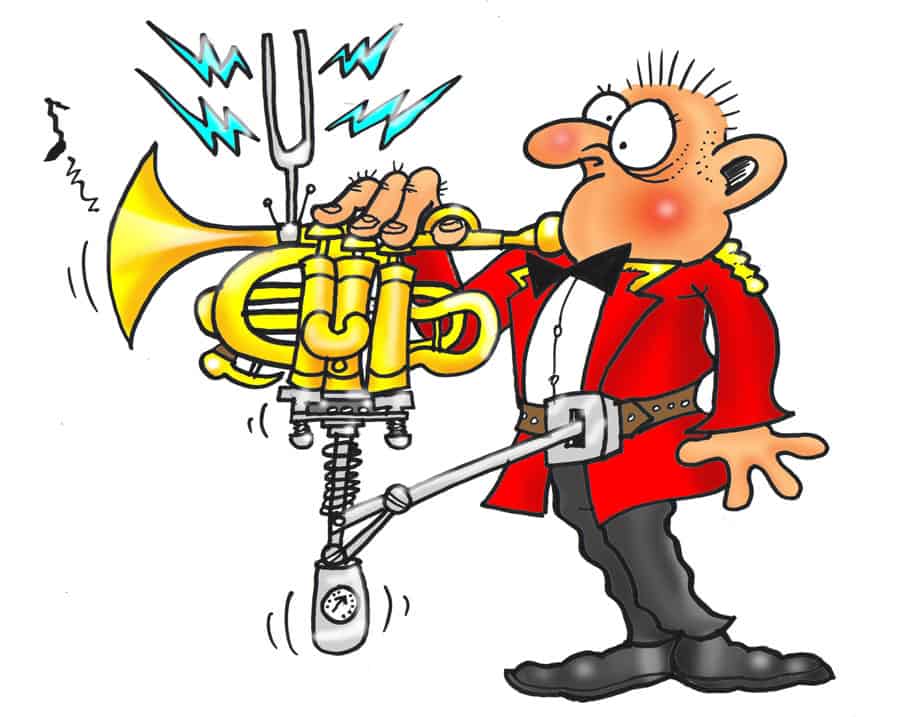Tuning up – the biggest pain in brass banding
Tuning up is the bain of the brass banding world. Don’t you just love it when you hear the words “Let’s have a tune up”.
The conductor lifts the dreaded contraption off the stand, spends another ten minutes fiddling around trying to get it to work, discovers the battery is flat, replaces them and resets, then goes about checking everyone section by section. This is usually carried out either at the very beginning of a rehearsal when even the teapot in the band room is shivering or, right at the end when everyone’s lip is a shredded mess in absolute tatters.
Good conductors with perfect pitch don’t need these infernal gadgets. They just know. So, what is perfect pitch? — and no, it isn’t when you throw a baritone down the toilet and it doesn’t touch the sides. It’s the ability to recognise the pitch of a note or produce any given note; a sense of absolute pitch, and according to the University of Chicago, it can be learned.
Which brings me to the trombone section. You know, those weird-looking things that an instrument maker created in the fifteenth century before valves and decent pipe benders were invented. Slides mean guess work.
A trombone player making a decision is worrying. A trombonist guessing is dangerous and a section of three is catastrophic. Where to position the slide to play ‘any given note’ and — be in tune. As we all know, a trombone player that consistently plays in tune is as rare as a comfortable bed at Blackpool.
If they can’t perform this vital task, why do they opt to play this tricky little beast? To find out, we have to travel back in time to when they were first given a brass instrument. Normally with valves. Usually a battered old cornet from the bowels of the store cupboard. After a few months, the poor little mites discover they can blow the instrument straight, but as far as finger coordination goes—well! The only other option is percussion or the trombone.
As they have no finger coordination and there is a strong possibility of having to juggle four sticks at once on a marimba, they chicken out. Then swap cornet for the beast, a hand-held ground to air missile launcher with slide.
I believe trombone, which comes from the Italian word ‘Tromba’ plus the suffix ‘one’, meaning big trumpet, should be renamed ‘The Approximator.’ This is a slightly more polite version of what translates to – ‘get away with murder.’ One approximator is bad enough, but three! They are also right in your face with the bell facing out. Any shift on the slide slightly out is picked up immediately by even the most audibly challenged adjudicator.
These metal monsters are not subtle unless you’re at the absolute top of your tromboning game such as Chris Thomas and John Barber.
For us mere mortals, what is the answer? Valve trombones are a non-starter. You may as well play a baritone or euphonium, but does anyone remember ‘Alpine Echoes’, played on an echo cornet? Yes, that old chestnut, composed by Basil Windsor at the turn of the last century. Convert that cornet technology to a trombone with a slide and valves. The valves keep the tuning just about bearable and a quick flick of a lever brings in the slide for glissando’s – perfect.
Well, almost. It would probably take an eastern European shot putter to lift the instrument and the cost would double. But there is no reason it can’t be done if your band has buckets of dosh. Oh… and three Amazonian trombonists.
Back to tuning the band. In this technological era, with auto levelling TV cameras, self-driving cars and so called pop superstars who can only sing in tune with electronic enhancement, you would think brass manufacturers would have cottoned on. Imagine a device strapped to a cornet where all you have to do is push the valves down and blow and tuning is automatically compensated. Even the band numpty would sound great.
As an afterthought – what is the only way to get a brass band trombone section to play in tune? Simple—shoot two of them!

